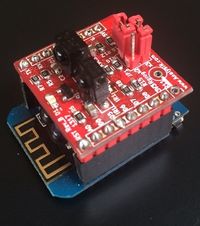A.IR Shield ESP8266/ESP32 TRx: Difference between revisions
No edit summary |
|||
| Line 17: | Line 17: | ||
The default port for communicating with AnalysIR is 9449 (declared via webServerPortAnalysIR) | The default port for communicating with AnalysIR is 9449 (declared via webServerPortAnalysIR) | ||
- First Disconnect the Shield from the Wemos D1 Mini | |||
- Copy the supplied firmware into the Arduino IDE | |||
- Make sure you have added support for ESP8266 to the Arduino IDe. (If not do so now, before proceeding.) | |||
- If you have not used the ESP8266 with the Arduino IDE before, please do so now and try out several of the example sketches before starting with this shield. | |||
- Make the configuration changes as discussed above within the sketch and proceed to compile using the Arduino IDE. | |||
- Once the compile completes successfully, you can proceed to load the firmware to the Wemos D1 Mini(Wemos). | |||
- Then disconnect the Wemos D1 Mini and insert the shield, with the IR LEDs at the opposite end to the USB connector. Do not insert the shield until the correct firmware is loaded. | |||
- IMPORTANT: Make sure the IR LEDS are at the opposite end of the USB connector before inserting the shield and powering up. All of the pins of the Shield should be interted into the female headers of the Wemos D1 Mini. | |||
- Insert the USB cable into the Wemos and into your Windows PC or other USB power source (WiFi only). | |||
- Start analysIr on the PC. | |||
'''Serial/USB:''' | |||
- From AnalysIR, select the correct COM port number from the drop-down at the bottom of the Main window. The indicator should turn dark green after a short delay. | |||
- Select A.IR Shield ESP8266 Serial from the Source menu. | |||
== AnalysIR Setup == | == AnalysIR Setup == | ||
Revision as of 09:43, 8 September 2017

Where to purchase
Visit AnalysIR's IR Shop where you will find this and a range of similar Infrared solutions.
Data Sheet
The data sheet can be found by clicking here
Loading Firmware
You will receive a csource copy of the firmware after your order is shipped. The firmware has an option to use a serial USB connection to AnalysIR or a WiFi connectiom (only when on the same WiFi network).
SerialUSB Configure the definition for useWIFI as false to connect via serial USB.
WiFi Configure the definition for useWIFI as true to connect via WiFi. In addion you must also configure the definitions for SSID (mySSID) and WIFI password (myWiFiPassword)
The default port for communicating with AnalysIR is 9449 (declared via webServerPortAnalysIR)
- First Disconnect the Shield from the Wemos D1 Mini - Copy the supplied firmware into the Arduino IDE - Make sure you have added support for ESP8266 to the Arduino IDe. (If not do so now, before proceeding.) - If you have not used the ESP8266 with the Arduino IDE before, please do so now and try out several of the example sketches before starting with this shield. - Make the configuration changes as discussed above within the sketch and proceed to compile using the Arduino IDE. - Once the compile completes successfully, you can proceed to load the firmware to the Wemos D1 Mini(Wemos). - Then disconnect the Wemos D1 Mini and insert the shield, with the IR LEDs at the opposite end to the USB connector. Do not insert the shield until the correct firmware is loaded. - IMPORTANT: Make sure the IR LEDS are at the opposite end of the USB connector before inserting the shield and powering up. All of the pins of the Shield should be interted into the female headers of the Wemos D1 Mini. - Insert the USB cable into the Wemos and into your Windows PC or other USB power source (WiFi only). - Start analysIr on the PC. Serial/USB: - From AnalysIR, select the correct COM port number from the drop-down at the bottom of the Main window. The indicator should turn dark green after a short delay. - Select A.IR Shield ESP8266 Serial from the Source menu.
AnalysIR Setup
Required for WiFi only - First make sure that the IP Address and port numbers for ESP8266 are configured correctly in the AnalysIR.ini file (Use Menu->FIle->Explore from within AnalysIR to locate the correct directory) Select either A.IR Shield ESP8266 WiFi (CTRL+ALT+6) or A.IR Shield ESP8266 Serial (CTRL+ALT+7) from the Source Menu.
IR Power Headers
Inserting Shield into Wemos D1 Mini
Make sure the the 2 IR Leds are at the same end as teh PCB antenna on the Wemos D1 Mini (opposite end to the usb connector). All pins of the shield should be inserted into the female headers.
LEDs
There are 2 LEDs. The first is located on the Wemos D1 Mini (usually blue). This LED is on the same IO pin as the IR send pin of the shield. After start-up it will always appear on. If this is an issue, it is relatively easy to remove this LED with a soldering iron. The second LED is at the front of the shield and after startup will briefly flash red as IR signals are transmitted. However, when both IR power jumpers are installed, the LED may not flash or be very dim. This is normal behaviour and is related to the use of the red LED as part of the constant current driver circuit for the IR LEDs.
==
Pinouts ==